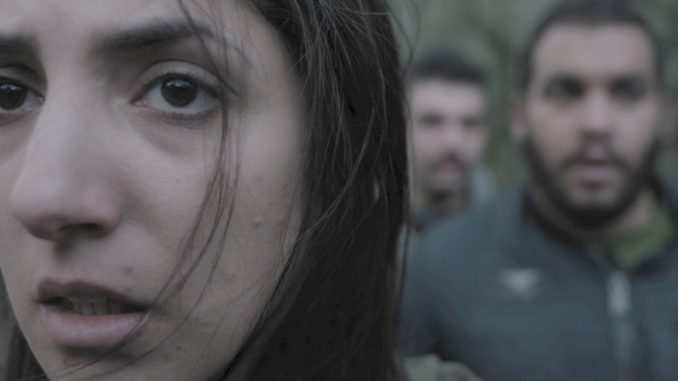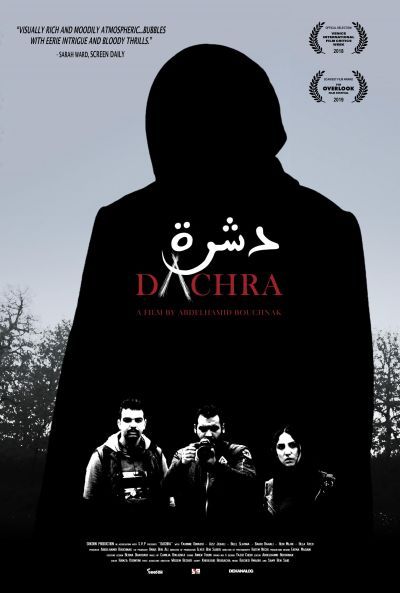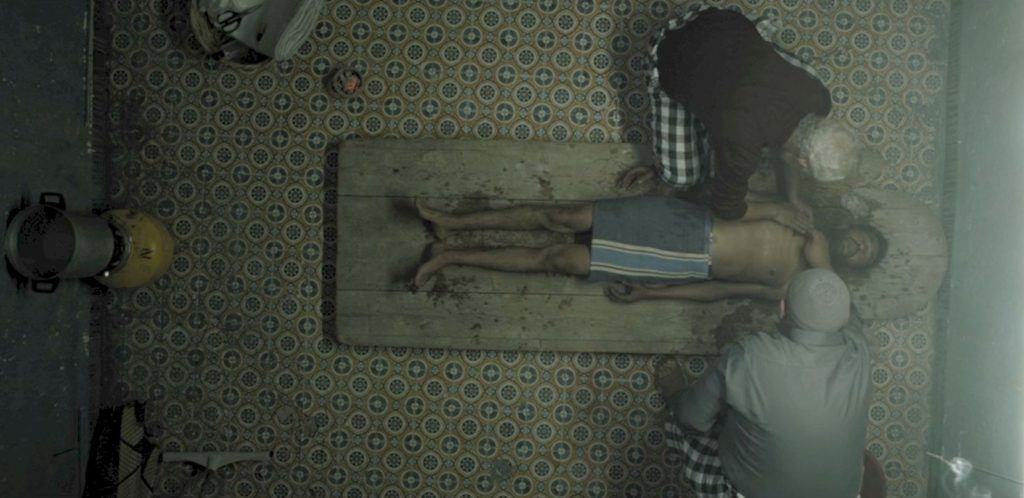
Rating: C
Dir: Abdelhamid Bouchnak
Star: Yassmine Dimassi, Aziz Jebali, Bilel Slatnia, Bahri Rahli
I am pleased to report that I was able to recall where Tunisia is on the map. Initially, I wasn’t sure (“No, I think that’s Morocco?”), but did eventually recall successfully that it is the little one, squished in between Algeria and Libya. That is, however, probably the limit of my knowledge about the country, and certainly the limit of my knowledge about Tunisian cinema. To be fair, there isn’t a lot of it to know about. The first home-grown feature, Al-Fajr, was not made until 1966, and they started submitting consistently to the Oscars as recently as 2016. There are still estimated only to be about fifty cinema screens in the whole country, for a population of over eleven million.
So, the initially impressive statement that Dachra “became Tunisia’s biggest homegrown box office hit in a quarter century,” is probably less meaningful than it would initially appear. I don’t know how many movies a year are made, but lists such as the BFI’s 10 great Tunisian films, doesn’t exactly contain crowd-pleasers. If that’s what local cinema is mostly like, I would be clutching like a drowning man at this, reported to be the country’s first horror movie. That it’s basically The Blair Witch Chainsaw Massacre is only a minor demerit, when the alternative is a film about “a lonely middle-aged widowed mother whose chance encounter with a belly dancing cabaret offers an escape from her feelings of isolation.” Nah, I’m good, thanks.
 On that basis, I’m inclined to look upon this a little more kindly than I would, were it an English language movie. Film-makers here should know better; I can’t demand the same thing of a country’s debut into the genre. I will say, it looks good, especially considering a budget reported by Variety of $80,000. For comparison, it’s less than one-third the cost of Terrifier 2, which visually, resembles something a Dobermann shat out. It also deserves some slack since I’m unaware of the state of local censorship in Tunisia. While certainly seeming tame in comparison to contemporary Western horror, Tunisia is 99% Sunni Islam, not a religion typically associated with unfettered artistic freedom. Except in Indonesia. They love their gore there. I have no clue about Indonesia.
On that basis, I’m inclined to look upon this a little more kindly than I would, were it an English language movie. Film-makers here should know better; I can’t demand the same thing of a country’s debut into the genre. I will say, it looks good, especially considering a budget reported by Variety of $80,000. For comparison, it’s less than one-third the cost of Terrifier 2, which visually, resembles something a Dobermann shat out. It also deserves some slack since I’m unaware of the state of local censorship in Tunisia. While certainly seeming tame in comparison to contemporary Western horror, Tunisia is 99% Sunni Islam, not a religion typically associated with unfettered artistic freedom. Except in Indonesia. They love their gore there. I have no clue about Indonesia.
The template early is definitely Blair Witch, beginning with an opening pronouncement this was “inspired by true events.” Further investigation reveals the key word here is “inspired”. It’s true, to about the extent Monty Python and the Holy Grail is a historical documentary. Apparently, Tunisia still has a problem – and not just in remote or rural areas – with witchcraft. A study in 2022 discovered 90% of Tunisians believe in it, the highest figure of any country surveyed. The end credits tell us, “In North Africa, hundreds of children are victims of acts of witchcraft,” which feels strangely like the kind of dramatic, yet unsubstantiated, statement made during the Satanic Panic in the eighties. Some casual Googling didn’t turn up much support for it, so Film Blitz fact-checkers currently rate this claim “UNPROVEN”.
Similarly to Blair, we have three wannabe journalists digging into a local legend. University students Yassmine (Dimassi), Walid (Jbali) and Belil (Belil Slatnia) have to come up with a fresh topic for a submitted investigative report, and decide to do one on a woman called Mongia. She was found naked and injured twenty years ago, and has been institutionalized ever since, barely saying a word. Her reputation has only grown since, with whispers that she is a witch, and violent attacks on the staff. The trio head for the asylum, only to find its director flat-out denying Mongia is a patient in the facility. A little bribery gets them in the side door, and while not much is gained from their encounter with the resident, they decide to explore around the location where she was found.
This is where it shifts into Texas Chainsaw mode, as the group find themselves encountering the locals, for whom the reporters are wildly unprepared. The residents seem very keen to have the guests join them for dinner, if you know what I mean, and I think you do. What the remaining hour of the film shows, is that not only have Tunisian film-goers not seen a horror movie before, Tunisian film characters have apparently not seen one either. For Yassmine and her friends blithely ignore blatant warning signs and ominous happenings, until it’s too late. With a whole forty minutes left, a local explicitly tells the heroine, “Run away. Now.” Spoiler alert: she, in fact, does not.
 Despite being nicely photographed, its running time, approaching two hours, certainly feels too long for the content. The entire first section, covering their visit to see Mongia, ends up being almost irrelevant. It’s a shame, since this part perhaps has more potential than what follows. A deeper exploration of the witch-or-not, might have offered a better glimpse into those widespread beliefs mentioned above. Instead, we basically get a vaguely Arabic flavoured variant of the “rural nightmare”, which pits civilized city folk against the feral, rural inhabitants. Bouchnak throws in other elements, like the spooky, red-coated child, some of which work on a superficial level,. Yet they don’t do a lot to shore up the central narrative, which suddenly rushes into a conclusion at the end.
Despite being nicely photographed, its running time, approaching two hours, certainly feels too long for the content. The entire first section, covering their visit to see Mongia, ends up being almost irrelevant. It’s a shame, since this part perhaps has more potential than what follows. A deeper exploration of the witch-or-not, might have offered a better glimpse into those widespread beliefs mentioned above. Instead, we basically get a vaguely Arabic flavoured variant of the “rural nightmare”, which pits civilized city folk against the feral, rural inhabitants. Bouchnak throws in other elements, like the spooky, red-coated child, some of which work on a superficial level,. Yet they don’t do a lot to shore up the central narrative, which suddenly rushes into a conclusion at the end.
Not helping matters is the near-constant bickering between the three proto-reporters. Within a few minutes, it feels as if Walid and Belil in particular, do not want to spend time with each other, a situation which persists intermittently for the rest of the movie. And if they don’t, why should anyone else? Though I did laugh at one man taunting the other after he has thrown up, “Need your gynecologist?” Some things are universal it appears. Shame this leans more on those clichés, rather than taking its position as a national ground-breaker, and spinning into something equally as innovative in terms of its plot.
This review is part of our October 2024 feature, 31 More Countries of Horror.
